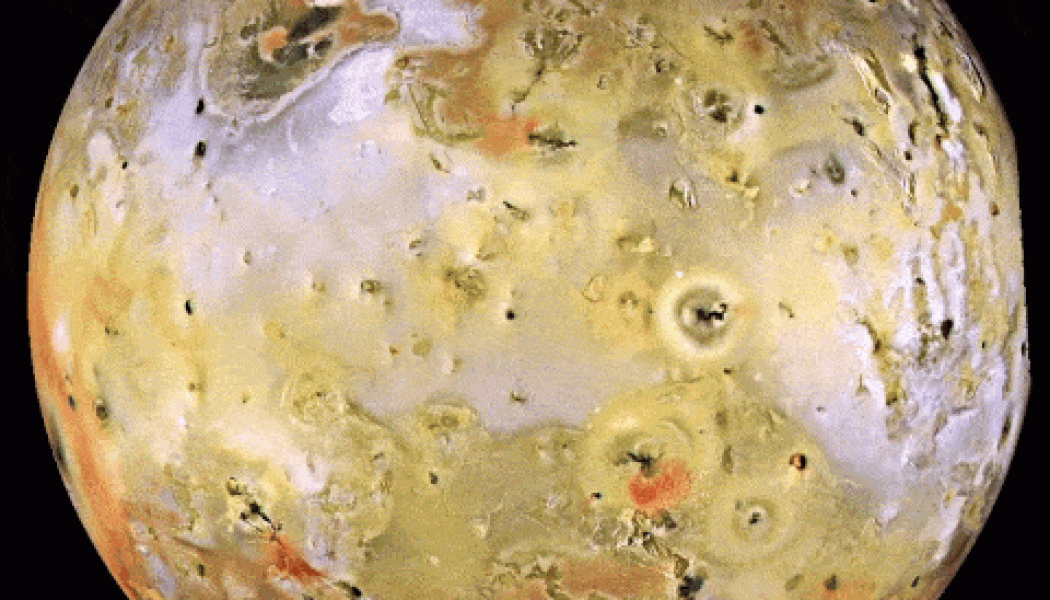Around 4.5 billion years ago, our solar system was born from a violent cloud of gas and dust. That spinning disk of interstellar material formed comets, asteroids, the planets, and their moons.
The first moon we discovered was, of course, our own. Next, the discovery of Io, Europa, Ganymede, and Callisto by Galileo Galilee in the 17th century restructured our understanding of the universe. “That’s the beginning of the scientific era, in my mind,” astronomer David Jewitt of the University of California, Los Angeles tells Popular Mechanics. Over the years, we’ve constructed powerful telescopes and lofted endeavoring spacecraft toward the stars, cueing a slow trickle of fascinating lunar discoveries.
According to NASA’s website, there are 214 moons in the solar system: 158 confirmed moons and 56 provision moons—ones we suspect may be there or have spotted once but haven’t yet confirmed. For this ranking, we’ve included all confirmed moons and a few “bonus” moons. As our ability to view the cosmos becomes more sophisticated, we’ll certainly spot more moons orbiting our solar system’s distant planets—and we’ll rank them accordingly.
Moons are far from simple celestial objects, so before we dive in, here are a few helpful definitions to guide you along your cosmic journey:
Prograde: A moon that orbits its object in the same direction as that object’s rotation.
Retrograde: A moon that orbits its object in the opposite direction of that object’s rotation.
Regular: These moons have relatively small orbits, which are often circular and roughly hover along the parent object’s equatorial plane. These moons likely formed alongside their parent body, accreting material as they zipped along their early orbits.
Irregular: Irregular moons often have large, eccentric orbits that don’t neatly circle the object’s equator. Most irregular moons are thought to be “captured,” meaning that got tangled up in the orbits of the larger body and stayed there.
Eccentricity: Objects with a more circular orbit have an eccentricity closer to 0.0. Objects with a more elliptical orbit have an eccentricity closer to 1.0.
You may agree. You may disagree. Or, keeping good company with one famous astronomer, you may wonder why in the hell you’d rank moons in the first place: “Do you really need to rank them all? There are hundreds.”
Without further ado, we present an entirely subjective ranking—peppered with scientific “moonpinions”—of every confirmed moon in our solar system.
26. Rhea
Saturn’s second largest moon, Rhea, was the first moon discovered to have a ring. In 2010, the moon was found to have an extremely thin exosphere with molecules of—you’ll want to sit down for this—oxygen. It was the first time oxygen had been spotted in an atmosphere other than Earth’s. Don’t hold your breath (or maybe do), there’s not enough to sustain life.
25. Epimethius and 24. Janus
The potato-shaped moon Epimetheus is in lock step with its sister moon Janus. They share the same orbit around Saturn, in a phenomenon called a co-orbital condition. The two moons may have begun their life as a single object, says Cassini mission project scientist Linda Spilker.
“They are so big that they cannot physically pass each other,” Spilker says. Epimethius, the inner moon, goes a bit faster than the outer Janus. “As the inner one slowly approaches the outer, they switch places,” she says.
“They’re kind of bizarre looking, but they do this intricate dance every four years,” Spilker says.
23. Naiad and 22. Thalassa
Naiad and Thalassa are seemingly stuck together in a mystifying, never-before-seen “Dance of Avoidance.” Neptune’s innermost moon, Naiad, has a strange wobbling orbit that shifts in accordance with nearby Thalassa’s orbit. The inner moon’s orbit is tilted by five degrees, and bobs up and down, in circles around Thalassa’s steady, equatorial orbit.
This cosmic do-si-do helps keep the moons stable even though they swing incredibly close to each other at their tightest pass—roughly 2,200 miles or about the distance from San Francisco to Chicago. Scientists aren’t sure what kicked off this orbital resonance, but it’s likely some sort of collision was involved.
Unfortunately, it’s a desperate love story for the two, tiny dancers. Thalassa also has what’s called a decaying orbit, which means it’ll eventually collide with Neptune.
21. Hyperion
Saturn’s pock-marked Hyperion looks like something you’d find in the aisles of Bed Bath & Beyond. The dark spots on Hyperion’s surface, Spilker says, are called sun cups. “If you’ve ever watched it snow and the snow gets dirty, the darker material melts faster and you create sun cups.”
It’s not just the spongy appearance that makes Hyperion so fascinating. It’s one of a handful of places in the solar system that carries a static charge. It actually zapped Cassini with a beam of electrons—the equivalent of 200 volt charge—as the spacecraft zoomed by in 2005.
“It’s just a very whacky looking moon,” Spilker says. “It’s very unusual.”
20. Callisto
Callisto is a literal relic. Scientists believe the moon of Jupiter—the third largest in the solar system—has the oldest, most cratered surface in the solar system. Recent estimates suggest it’s about 4.5 billion years old—roughly the same age as Jupiter. Sure, we have samples of Earth rocks and moons rocks that are the same age, what’s surprising is that all of Callisto’s surface is that old.
“Aesthetically, I like the look of Callisto a lot,” UCLA astronomer David Jewitt tells Popular Mechanics. The astronomer, who discovered many of the moons on this list, likens Callisto to a smashed Christmas ornament. Long ago, something smashed into the icy moon, forming the most notable feature on its surface—a 2,361-mile-wide crater called Vahalla. The weight of that crater has buckled the surface in that region, forming a ring of concentric circles around the crater.
The mysterious moon has a very, very thin atmosphere, called an exosphere, that’s rich in carbon dioxide, and trace amounts of oxygen and nitrogen. Recent research has suggested that the moon may also have a salt water ocean deep below its crust.
19. Pan and 18. Atlas
Fact: Pan and Atlas are just two tiny ravioli whizzing through space.
So, why do these small moons look like like pasta? As these flying saucer-shaped moons zip through their respective gaps in Saturn’s rings, they scoop up material, which, thanks to rotational forces, slides toward the equator.
17. Dactyl
Dactyl stunned the world when it was discovered in 1994. It was the first moon to be observed and photographed orbiting an asteroid. For that reason, we’ll always love it.
16. Tethys
“Let’s give a shout out to Tethys, the moon that’s made of pure water,” says planetary scientist Kevin Zahnle of NASA’s Ames Research Center of the Saturnian moon. “It’s like a teardrop in space. Sorry—a frozen teardrop in space.”
One of Tethys’ strangest features is a set of red-hued arcs that streak across the surface that scientists suspect are caused by chemical impurities. It’s a relatively rare sight. Only a few objects in the solar system have rust-colored marks on their surface.
Both Tethys (and Mimas) have curious heat signatures. Thermal observations that Cassini took in 2011 revealed Pac-Man-shaped signatures. Researchers believe that the moons’ chillier regions are bombarded with electrons that harden the icy surfaces, making it tougher for them to warm up.
15. Mimas
“That’s no moon!”
Obi-wan Kenobi was right about the Death Star. This celestial object, however, is a moon. Mimas, one of Saturn’s many moons, is roughly the same size as its fellow Saturnian neighbor, Enceladus, and appears to have a subsurface ocean, too.
But it’s best known for Herschel Crater, which—sci-fi buffs will attest—makes the moon look a whole lot like the Death Star. “It would be cool to go figure out what caused the giant impact crater, why it’s so huge on such a small body and why the body didn’t blow apart” upon impact, says planetary scientist and geochemist Justin Filiberto of the Lunar and Planetary Institute.
14. Deimos and 13. Phobos
Mars’ two moons, Phobos and Deimos, were proposed in the 17th century by the famed astronomer Johannes Kepler and discovered more than 200 years later by Asaph Hall. They’ve intrigued scientists ever since.
Deimos is the smaller of the pair, with a mean radius of about 3.9 miles. Both Deimos and its companion moon have a nearly circular orbit, suggesting they may have formed near the Red Planet, possibly the result of a massive Martian asteroid impact that shed debris.
Phobos has a mean radius of 6.9 miles and is marred by the massive Stickney Crater, which takes up almost half of its surface. Phobos is “barely held together,” says heliophysics PhD student Gwen Hanley of UC Berkeley. “It can fall apart due to stress at any time, and I relate to that as a grad student.”
Ultimately, Phobos is doomed. The moon has a decaying orbit, which means Mars tugs on Phobos, drawing it slightly closer—by as much as seven-tenths of an inch per year. Eventually, astronomers believe the moon will either be torn to bits, forming a ring around Mars, or potentially smash into the Red Planet.
Deimos, on the other hand, is slowly scooting away from the planet. Astronomers believe that its outwardly decaying orbit will eventually fling the moon into space.
Japan’s space agency, JAXA, plans to launch a mission to investigate the pair in 2024. The Mars Moon eXploration mission will attempt to bring samples of Phobos back to Earth. “One of the justifications for going there is that there should be a few percent Martian material on the surface,” astromaterials curator Francis McCubbin of NASA’s Johnson Space Center told Popular Mechanics. “It’s sort of like our first Mars sample return.”
12. Daphnis
Daphnis is the second tiniest moon in the top 15, but it’s one of the most charismatic. With a mean radius of just 2.4 miles, Daphnis zips around Saturn, tucked in the Keeler gap between the planet’s A ring and the B ring.
The gravitational pull of the tiny rock tugs at dust particles along the edge of the Keeler gap, carving waves of material that lead and trail the moon. During Saturn’s equinox, when the rings’ plane aligns with the sun, these tiny perturbations cast mesmerizing shadows on the planet.
11. Miranda
Dubbed the Frankenstein moon, Miranda looks like it’s been torn apart and stitched back together a thousand times. The innermost of Uranus’ five major moons, Miranda has an intriguing set of surface features. There’s the “coronae,” or crater-free splotches of concentric ridges on its surface, which researchers believe may be composed of ammonia-water lava—a striking idea considering the moon should be too cold to support geologic activity.
And then there’s Miranda’s most striking feature, Verona Rupes, the tallest cliff in the solar system. The shear cliff drops about 33,000 feet, or five times the depth of the Grand Canyon. “If you stepped off, you’d have time to read the newspaper on the way down,” Cassini mission project scientist Linda Spilker says of the eight-minute-long fall.
There are several ways that Miranda’s impossibly splintered surface could have formed. One suggests that the moon was split open by a massive impact and then quickly pulled back together. Others believe that perhaps these regions melted and refroze after a series of meteorite strikes.
“All these satellites, particularly the ones far away and small, are surprising us,” planetary scientist Mark Hofstadter of NASA’s Jet Propulsion Laboratory tells Popular Mechanics. Miranda is certainly no exception.
10. Didymoon
“It’s tiny and it’s orbiting an asteroid! How can you not like something like that?” says Charlotte Götz, a research fellow at the European Space Agency.
At about 524 feet in diameter, Didymoon, which orbits the asteroid Didymos, is about as large as one of the great pyramids in Egypt. The tiny moon is one of the solar system’s quaintest features, but it’ll take part in what is arguably one of the most important space missions of all time.
Didymoon and Didymos are the target of an international collaboration to test one of humanity’s most daring plans: deflecting a potentially hazardous object that could strike Earth. It’s a kamikaze mission for the intrepid spacecraft—dubbed the Double Asteroid Redirection Test (DART)—which will fling itself into the small moon in an attempt to knock it off course. A follow-up craft called Hera will be close behind to measure the effects of the impact and report back to scientists.
Thankfully for everyone back home, the Asteroid Impact and Deflection Assessment (AIDA) is just a dress rehearsal. Still, it’s our best shot at averting a future catastrophe here on Earth.
9. Charon
Whether you pronounce it Shar-on (as the moon’s discoverer, James Christy, did) or KAR-on, we can all agree that Pluto’s moon Charon has a lot going for it.
First, the moon has an orbit that’s completely unique to the solar system. Charon and its dwarf planet, Pluto, are part of what’s called a double planetary system, meaning they both orbit the same point. They’re also mutually tidally locked, which means that if you were standing on Pluto (which completes a rotation in 6.4 Earth days) you’d always see the same face of Charon (which takes 6.4 Earth days to orbit the dwarf planet) hanging in the same spot in the sky.
“Charon has this really dark cap of material,” graduate student Jack Conrad of the University of California, Santa Cruz tells Popular Mechanics. That red dusting of methane comes courtesy of Pluto. The dwarf planet isn’t able to hold onto its atmosphere, so it’s constantly spitting material onto its nearby moon. That methane gets trapped near the poles. Ultra-violet light from the sun converts the methane into hydrocarbons and, eventually, organic compounds called tholins.
One thing is certain: the moon has a violent past. “Charon seems to have just ripped itself asunder,” Conrad says. Scientists have found evidence of cry0volcanism on the tiny, icy moon. A 1,000-mile-long canyon tears across Charon’s southern hemisphere and the moon has a single, towering mountain, which juts out of a deep hole on the moon’s surface.
Conrad put it simply: “Charon’s lumpy, but that’s all right.”
8. Moon Moon
“I can’t tell you how many times I was a little kid driving back from my grandmother’s house to the southside of Chicago, looking out the window and staring at the moon,” former NASA astronaut John Grunsfeld tells Popular Mechanics. “Everyone has their own personal view, but I have to start with our moon because it’s our moon.”
Since the dawn of time, humanity has been transfixed with our closest planetary neighbor. That soft gray rock, suspended in the night sky has inspired generations of artists, poets and explorers. Like so many other astronauts, Grunsfeld credits the lunar landing for inspiring an early interest in science. “Didn’t get there, but I got to Hubble three times, so that’s not too bad,” he says.
Formed billions of years ago after a Mars-sized body slammed into Earth, the moon sways Earth’s tides and stabilizes Earth’s wobble on its axis, according to NASA, all but securing a liveable climate. There has even been evidence to suggest its tidal forces influence seismic activity here on Earth.
“It’s close enough that you can see its surface and identify craters, mountain ranges, rilles, valleys, escarpments, and other features,” Bing Quock, assistant director of the Morrison Planetarium in San Francisco, tells Popular Mechanics. This opportunity allows scientists to explore some of the moon’s most intriguing features like the Lunar X or the chains of craters on its surface. It’s one of just a few surfaces in the solar system that generates an electrostatic charge.
“In the permanently shadowed regions near the poles are some of the coldest temperatures recorded anywhere in the solar system,” says planetary scientist Rebecca Ghent of the Planetary Sciences Institute. Orbiting spacecraft have discovered water ice—a valuable resource we’ll tap into if we aim to explore distant reaches of the solar system.
And, of course, we’ve been there. We’ve sent 105 spacecraft to the moon and 12 astronauts have set foot there. We’ve walked, skipped and stumbled across its surface, planted flags and carved donuts into the lunar regolith. We’ve studied some of the 842 pounds of geologic samples we retrieved, detailing every crack, crevice and grain. “Still gives me chills just to think about it,” Quock says.
Finally, our excursions to the moon have allowed us a unique look at our own home. It’s been dubbed “the Overview Effect,” and a number of astronauts have shared how looking back at Earth from the moon has shaped their perspective upon returning home. “Just as valuable as what we learned about the Moon during [the Apollo] missions was the sobering perspective gained about Earth as a fragile, delicate oasis of life in the unimaginable emptiness of space,” Quock says.
We’ll be going back soon. NASA aims to land the first woman and next man on the moon by 2024. It’s ambitious, but there’s no doubt that when we eventually return to the lunar surface, a whole new world will be waiting for us.
7. Iapetus
“I think Iapetus might be the most interesting one,” planetary scientist Scott Sheppard of the Carnegie Institute for Science tells Popular Mechanics.
It’s known as the Yin-Yang moon because of its mysterious coloration: one side of the moon is covered in a massive blotch of dark material while the other is a pristine shade of white.
It could be that Iapetus is plastered with the guts of another fellow moon, Phoebe (86). When the pockmarked Phoebe sheds material, that rocky, icy debris lands on Iapetus’ night side, and eventually, particle by particle, hops toward the moon’s poles. “We think Iapetus is like a snowplow, just picking up the dark dust,” Sheppard says.
The moon is also home to a towering equatorial ridge. “There’s some thought that maybe Iapetus had a ring and the ring collapsed onto the surface and created—a long time ago—this mountain range,” says Spilker. Others have suggested that the mountains arose when the moon was first forming and spinning much faster, and thus slinging material toward the equator.
Sheppard is perhaps most intrigued by its strange inclination. Most of Saturn’s regular moons, the ones that formed along with it, lie along the same plane. But Iapetus is about eight degrees outside that plane. “That suggests that Iapetus may not have formed with Saturn,” Sheppard says. “Maybe it is a captured moon.”
6. Ganymede
“It’s the most underrated moon in the solar system,” Jacob Abrahams, a grad student in the school of Earth and Planetary Sciences at UC Santa Cruz, tells Popular Mechanics. Jupiter’s Ganymede is also the largest in our solar system—larger than Mercury—and likely has a vast ocean of warm, salty water beneath its crust.
“It’s the only moon we’ve known yet which has its own magnetic field, and we don’t know why, really,” instrument scientist Glynn Collinson of NASA’s Goddard Space Flight Center tells Popular Mechanics. “It generates a very small magnetosphere—the smallest known to science.”
Scientists have long suspected that the moon may have a metallic iron core. Recently, the Hubble Space Telescope spotted ribbons of aurorae circle the moon’s poles. “Basically all of our physics and understanding breaks down, and everybody’s models go wrong, and everybody ends up yelling at each other,” Collinson says.
In 1996, the Hubble Space Telescope discovered evidence that Ganymede has a uber-thin atmosphere that contains oxygen. (Don’t get your hopes up. It’s not likely there’s enough to support life.) “We get to explore this thing and we have no idea how it works,” Collinson says. “It confounds us at every turn.”
5. Europa
In 2012, the Hubble Space Telescope snapped pictures of Europa which revealed massive plumes of water vapor jetting as high as 100 miles out into space. All hell broke loose. The plumes revealed that one of life’s key ingredients, liquid water, was abundant on Europa.
The tiny moon of Jupiter, Europa has been an object of fascination for centuries, but in recent years, there has been a rabid fascination with the nearly Moon-sized moon. Spurred by Hubble data, astronomers revisited old Galileo mission data and found similar evidence for plumes of water vapor, increasing the odds that the moon might host—at the very least—the ingredients for life.
The tiger-striped moon is covered in a thick crust of ice, ten to 15 miles thick, which sits upon a vast watery ocean, nestled atop a rocky mantle and iron core. That ocean contains more water than all of Earth’s oceans, planetary scientist Christopher Edwards of Northern Arizona University told Popular Mechanics.
The surface of the frozen moon is covered in linaea, a tangled network of salt-encrusted gashes thought to have formed by tidal forces. Researchers have long proposed sending a submersible to Europa which would drill down through the moon’s thick crust—perhaps slipping into one of these canyons—to explore the ocean beneath.
The moon is also home to a surface feature called “chaos terrain,” which are thought to be regions where blocky chunks of sulfur and salt-stained crust, which were laid upon buried lakes, subsided. It doesn’t get more badass than that.
“I think [Europa]’s got the highest probability of hosting some alien life in our solar system that we could go and find out if it’s there,” says former NASA astronaut John Grunsfeld. “We’re going to do that hopefully with Europa Clipper or some other missions.”
NASA’s Europa Clipper mission is set to launch for the frozen moon this decade. Once it arrives at Europa (after a six year journey), the spacecraft will conduct 45 flybys. Its array of scientific instruments will snap pictures, capture spectra and thermal images of geologically active moon, in an effort to more closely identify its most active regions.
We can’t wait to see what it finds.
4. Triton
Triton, the largest moon of Neptune, is an interloper. An outsider. A misfit. Planetary scientists believe the moon originated far from its parent planet, in the distant Kuiper belt, and was later sucked into the planet’s orbit.
“It’s really cool to think that there’s basically a captured Pluto orbiting Neptune,” says atmospheric and space physicist Dave Brain of the University of Colorado, Boulder. “It’s a very large moon, which means that capture was difficult unless it was part of a binary object.”
Of all the large moons in the solar system, it’s also the only one to spin in the opposite direction of its planet.
Dense Triton is also rockier than the other satellites that circle Ice Giants Neptune and Uranus, which are often made entirely of ice. “We think it might have an ocean underneath its icy surface on top of where there’s any rocky core,” says space and planetary scientist Adam Masters of Imperial College London. “Triton stands out as quite unique in that respect.”
Temperatures on the moon are frigid. When Voyager 2 zipped past Neptune and Triton, it took surface temperature readings, which revealed that the moon’s surface could drop to around -391 degrees Fahrenheit. Planetary scientists believe ammonia may be the key to keeping its hidden ocean liquid in spite of the freezing temperatures.
Triton’s shining, ice-covered surface reflects 70 percent of the light that it receives, according to NASA, and its thin, nitrogen-rich atmosphere has traces of methane, an indicator that it might be more alive, geologically speaking, than previously thought. Voyager 2 data revealed that like Enceladus and Europa, the moon may cast plumes of water high into space.
In January, NASA announced that a long-awaited mission to Triton will be up for consideration by the agency’s Discovery Program. If chosen, the Trident mission would set out to explore one of the solar system’s most intriguing moons before the decade wraps.
3. Enceladus
“All these wrong answers are wrong,” Frederik Johansson of the Swedish Institute of Space Physics told Popular Mechanics. “The true answer is Enceladus.”
Saturn’s tiny moon, Enceladus, didn’t look like much at first. “We thought it would be frozen solid,” says Spilker. “And yet, over the course of the 13 years of the Cassini mission, [we] discovered that it had a global ocean of liquid water, jets coming out of the south pole and evidence for hydrothermal vents.”
Scientists were so intrigued by the 310-mile-wide moon’s jets that they sent Cassini on a detour to investigate. It sailed through the icy plumes 23 times and made unbelievable discoveries. Critically, Spilker says the craft found hydrogen, carbon, nitrogen and oxygen in the plume—the “Big Four” ingredients of life—and strange nanocarbons which only form along hydrothermal vents.
The plumes spew this material into space; some of it floats off to seed Saturn’s E ring, but much of it falls back down to the moon’s surface. “Go to Enceladus. Just peak down, and see if there’s life in there—or potential for life in there,” Johansson says with a grin. “You don’t have to dig! Just peak down!” Spilker says it could be as simple as landing beneath a plume, sliding open a sampling tray and then jetting back to earth.
“We had so many clues,” Spilker said of Voyager 2’s flyby of the tiger-striped moon in 1981. “But it took Cassini to go back and figure it out. In an almost poetic twist, the moon is also the brightest body in the solar system—a beacon in more ways than one.
2. Io
“Io is the most volcanically active body in our solar system and in the known universe,” says planetary scientist Dan Spencer of the University of Oxford. “The volcanoes are so big that we can actually see them from telescopes based on Earth.” When astronomers mapped the violent world, they counted over 400 volcanoes (about 150 of which are active) on its surface. Some of them spew jets of lava hundreds of miles into space.
As Io sweeps by Jupiter, the planet drags particles off its surface, forming a small magnetosphere, or plasma torus around the moon. Its thin, noxious atmosphere is almost completely composed of sulfur dioxide gas, which condenses into sulfur dioxide ice when it passes through Jupiter’s shadow.
So, why is the moon so volcanically active? We have gravity to thank. Io is smack dab in the middle of a gravitational game of Tug-O-War. Io’s the recipient of an intense pull from the strong gravitational field of Jupiter as well as the gravitational fields of the neighboring Ganymede and Europa. Io is also subjected to some of the most powerful tidal forces in the solar system. Its surface bubbles and bulges, sometimes by as much as 330 feet and is constantly churning out new lava.
Because it is the closest Galilean moon to Jupiter and passes swiftly through the planet’s magnetic field, Io can also generate a serious electric current—around 3 million amperes. This jolt of electricity is shot back toward Jupiter, forming lightning in the planet’s upper atmosphere.
Because of its stunning—if not completely terrifying—features, it’s unlikely we’d ever find life on the moon. Despite this, it’s a high priority for planetary scientists who hope to learn more about Earth’s own volcanic past. Io is one of the proposed mission targets of NASA’s Discovery Program. Scientists have proposed to send a probe Io for closer look at the moon’s lava flows, which are stitched together like a psychedelic patchwork quilt.
For climate and space scientist Xianzhe Jia of the University of Michigan, the allure of the moon is simple: “It’s just so colorful.”
1. Titan
It was the perfect Christmas gift. On December 25, 2004, the tiny Huygens Probe—an integral facet of the famed Cassini mission—floated down through a thick haze and onto Titan’s surface. Images from the landing revealed a stunning world that looked not unlike our own.
“It has to be Titan,” Peter Gao, a post-doc in Astronomy at UC Berkeley, tells Popular Mechanics. “It is the only moon with a thick, significant atmosphere and the surface pressure is 50 percent higher than the surface pressure on Earth.” And while you would definitely need an oxygen mask, you could hypothetically walk around on the moon’s surface without a pressurized suit.
Titan’s atmosphere is flush with Nitrogen, just like Earth’s. But instead of oxygen, the next most abundant element in the moon’s atmosphere is methane. The moon is dominated by hydrocarbons like methane and ethane. Just as we find all three phases of water on Earth—liquid, water and gas—you can find all three phases of methane on Titan.
“You get a lot of chemistry that forms this orange, goopy haze that goes around the entire moon,” Gao says.” That’s why it looks orange. All of that chemistry eventually leads to methane and ethane storms near the surface.”
Aside from Earth, it is the only known celestial body to have liquid on its surface. Titan’s rivers, lakes and seas—like Kraken Mare—are filled with hydrocarbons. “It looks hauntingly familiar,” says Spilker of Titan’s varied landscapes. “And yet, it’s just cold.”
Instead of limestone or granite, the bedrock on Titan, which forms jutting mountains and large mesas is made from water ice. And then there are the dunes. Titan is home to a vast network of dune fields, which are sculpted by its nitrogen winds and made mostly of dark, hydrocarbon grains which, NASA suggests, resemble coffee grounds.
As if that weren’t enough, planetary scientists believe that a vast subsurface ocean of water and ammonia rests beneath all of these features, rendering Titan—along with Europa and Enceladus—a potential candidate for finding some form of life.
Everything about the moon is an enigma. It’s the second largest moon in the solar system and, with a mean radius of about 1,600 miles, the largest of Saturn’s moons. Rhea, the next largest moon of Saturn, has a mean radius of 475 miles. Researchers aren’t exactly sure how Titan formed. Nitrogen isotopes suggest it might have formed in the Oort Cloud. One recent theory suggests it formed within the safety zone of a planetary disk, which prevented it from being gobbled up by Saturn.
In 2026, NASA plans to launch the Dragonfly mission, a rotorcraft which will hopskotch to different regions on Titan’s surface, collecting data so that we can better understand the most mysterious moon in the solar system.








































